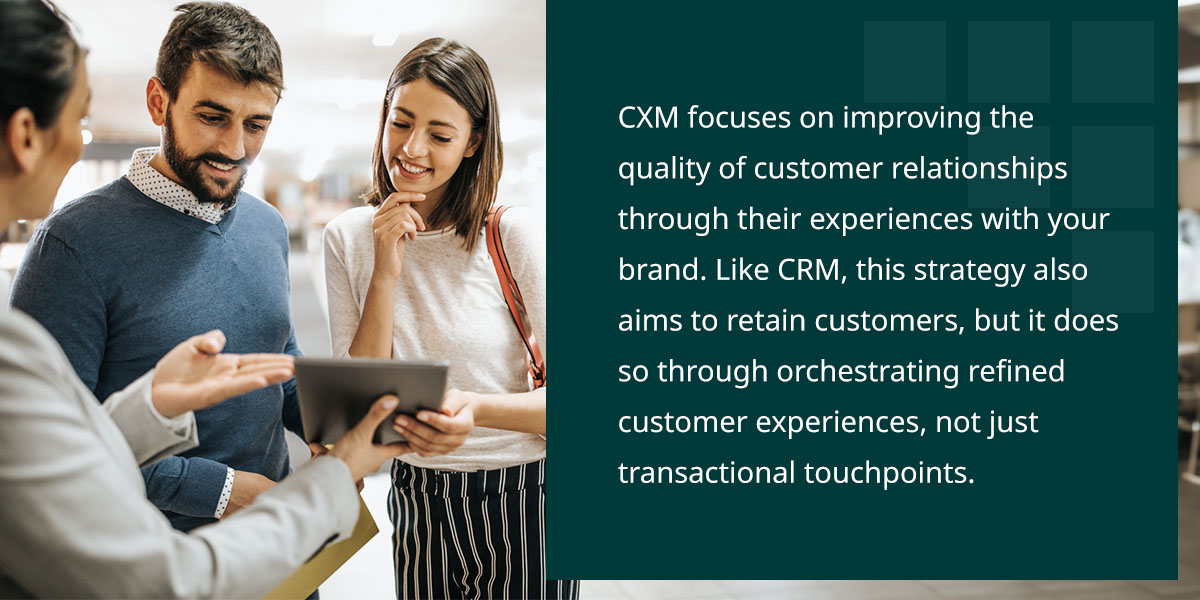Customer relationship management (CRM) and customer experience management (CXM) are two related elements of customer satisfaction, but each plays a distinct role. Knowing what makes these approaches different from one another can help you build an effective customer engagement strategy. Understanding the difference between CRM and CXM makes it easier to find ways to combine them to supercharge customers’ happiness levels.
What Is Customer Relationship Management?
The CRM business strategy creates and tracks user profiles to retain existing customers. These customer profiles include information like:
- How the person became a customer
- How often the customer buys from your brand
- How much the customer spends
These data points help brands understand customers’ needs and wants, and then use that knowledge to respond better to those desires. For example, a CRM profile might reveal a customer makes the same purchase around the same time each month. Your brand can use this information to increase engagement through emails and push notifications that advertise products this customer usually buys during this monthly purchase.
As a rule of thumb, CRM is the transactional side of a customer relationship. It focuses on purchasing habits to better inform marketing tactics and drive sales.
Why Does CRM Matter?
Maintaining customer profiles through a CRM strategy leads to key benefits, including the following.
Maximize Marketing Campaigns
Unique customer profiles provide data that makes your marketing campaigns more effective. By tracking factors such as the amount of money spent or the customer’s first product purchase, your marketing team can customize which items you promote and determine which customers are most likely to buy from a brand. When businesses understand how to target customers, the money spent on marketing campaigns generates a higher return on investment.
Increase Sales
CRM strategies help build a rich repository of information about customer behaviors. Customers’ browsing and purchase histories reveal essential information, like upcoming contract renewals, opportunities for upselling and more. With this information presented cleanly, sales teams can streamline the sales process and close relevant deals faster and more often.
Improve Customer Support
Knowing your buyer makes the customer journey more predictable. Stored CRM data becomes shared information that everyone on customer-facing teams can reference. Whether customers call to get product support or product recommendations, this data informs the answer. For instance, a CRM profile might reveal a buyer is loyal to one particular service that would complement another service. This information empowers sales reps to explain the added value to the customer and encourage the sale.
Having this information easily accessible allows teams to connect with customers in real time to offer more benefits from available services and build long-term customer relationships.
What Is Customer Experience Management?
CXM focuses on improving the quality of customer relationships through their experiences with your brand. Like CRM, this strategy also aims to retain customers, but it does so through orchestrating refined customer experiences, not just transactional touchpoints. Collecting customer data—like reviews, surveys and other types of feedback—is part of CXM. Generally, the CXM process includes gathering, tracking and organizing all steps in the customer journey and finding ways to improve them.
A core objective of CXM is interacting with every customer—not just reacting to unhappy ones. Fostering this level of interaction requires oversight of every touchpoint, from social media interactions and bill payments to reactions with your customer support team.
Why Does CXM Matter?
Using a CXM strategy can lead to some major benefits for your business.
Increase Revenue
CXM is all about building emotional connections and retaining existing customers. Returning customers spend 67% more than new customers, so focusing on retention can drive revenue growth. An effective CXM strategy relies on feedback from customers to thoroughly understand their goals. Meeting customers where they’re at can drive spending and overall loyalty to a brand.
Reduce Costs
Directing efforts and expenses toward customer retention through CXM can lead to significant cost savings compared to focusing on customer acquisition. Keeping existing customers costs less than acquiring new ones—anywhere from four to five times less.
Besides creating cost savings, focusing on retention can boost profits. In fact, data indicates that improving customer retention by just 5% can increase profits by more than 25%. That combination of money saved and profits earned can add up to some impressive figures.
Strengthen Brand Preference
Customers have more options than ever, and they also have more access to brand information than ever before. Creating positive and connected customer experiences encourages customer preference for your brand over others. Offering a customized customer experience is a considerable differentiator that sets your business apart from your competition, encouraging customers to choose your company and resulting in increased sales.
Getting more buyers to prefer your brand helps you build a more positive brand reputation. A largely positive public opinion makes driving conversions that much easier.
How CRM and CXM Work Together to Make a Successful Business
CRM and CXM are valuable strategies, and using them together can help you build strong relationships with your customers. Ultimately, CRM and CXM insights create a more seamless customer journey. Whether a person just learned about your brand or is looking to buy, you can use the information received from customer habits and feedback to make their experience enjoyable.
Many technology solutions exist to track data for CRM and CXM. Implementing these tools can help your company organize customer data and make it easy to access when making decisions. With customer information displayed clearly, your team can more easily identify areas that need extra support or improvement to deliver those meaningful customer experiences.
Explore Customer Experience Solutions From CSG
At CSG, we provide the tools your business needs to create extraordinary customer experiences. Strengthen your CXM and CRM with CSG Xponent, a platform designed to understand your customers and optimize the buyer journey. You can map, automate and refine customer journeys based on data and create more responsive communication channels. Let CSG Xponent help your organization maintain data-rich buyer profiles that personalize every customer interaction.
We understand the importance of powerful customer experiences, and our platform makes it possible to deliver them. Connect Xponent with your existing customer engagement system and master the entire customer lifecycle.
CSG is a proven leader in the world of customer experience. Our solutions continue to bring about impressive results for all types of companies. See what our platform can do for you—connect with us today.


